 The media and various government websites clearly and openly qualifying native kangaroos and possums as 'pest animals' needing to be 'culled'. But what if they aren't pests at all? The law protects those who kill protected native species under certain conditions but could there be non-lethal ways of dealing with the problem? Could this be part of a national strategy to drive the nails deeper into our native animals' collective coffins? It is no wonder we have the world's worst record for mammal extinctions with government attitudes like this.
The media and various government websites clearly and openly qualifying native kangaroos and possums as 'pest animals' needing to be 'culled'. But what if they aren't pests at all? The law protects those who kill protected native species under certain conditions but could there be non-lethal ways of dealing with the problem? Could this be part of a national strategy to drive the nails deeper into our native animals' collective coffins? It is no wonder we have the world's worst record for mammal extinctions with government attitudes like this.
On 26 October, 2010 in the Banyule and Nillumbik Weekly (1) there was an article about how kangaroos in Plenty Gorge in Greensborough, the North-Eastern suburbs in Melbourne are becoming a problem.
In this article the Invasive Animals Co-operative Research Centre says:-
“Kangaroos can cause serious damage to farm fences and crops, scare domestic livestock, such as cows and sheep, and cause motor vehicle accidents. Controlling numbers is essential for safety and productivity.
‘‘Kangaroos can also cause environmental damage, especially if they are confined on reserved land and their numbers are allowed to increase unchecked. Contraceptives may be useful for controlling kangaroo populations in confined areas or in the peri-urban area. However, much more work is required, including an assessment of their biological and ecological impacts, before they could be considered,’’ the centre’s latest report states."
In my mind many questions arise. Let’s examine all these claims to see if they are true:-
1. Invasive Animals?
What on earth is the Invasive Animals Co-operative Research Centre doing commenting on a non-invasive animal? Kangaroos are native animals and by definition are NOT invasive, exotic or feral. Why did this newspaper choose to quote from this organization and not the Department of Environment?
Invasive Species (IUCN definition):
Invasive species are organisms (usually transported by humans) which successfully establish themselves in, and then overcome, otherwise intact, pre-existing native ecosystems.
According to Dept Env website, kangaroos are not invasive species either.
2. Destruction to the Environment?
It is well known that cows and sheep, being hoofed, cause massive soil erosion and destruction of soil ecosystems, pollute the air, soil, waterways, contribute to deforestation and biodiversity loss and the drought. In short they are turning this country into a desert. So why are kangaroos being scapegoated for causing environmental damage when it is not the truth?
3. Damage to Fences?
If kangaroos cause damage to fences, isn’t it time farmers erected ‘kangaroo-proof fencing’ so that kangaroos do not enter farms and do not get entangled in barbed wire fences. What about the damage fences cause kangaroos, does it ever occur to them that fences are a worse hazard to kangaroos than kangaroos to fences? And what about the fact that livestock routinely damage fences? Should we cull livestock because they damage their own fences?
4. Damage to Crops/Competition with Livestock

According to CSIRO kangaroos hardly ever visit wheat farms. According to the Dept of Environment grazing pressure of kangaroos is very small 1-8% compared to livestock (92-99%). (2)
It is a proven fact that kangaroos do not eat crops (8). Graziers will normally budget 10 litres of water per day for sheep which doubles in hot dry summers. An average size kangaroo of say 25kg only needs only 1 litre of water per day to survive. (Hume 1999).
According to the CSIRO, kangaroos do not compete with sheep (3).
5. Scaring Livestock?
As for scaring livestock, it’s more likely that kangaroos would be scared by livestock. Kangaroos do not attack cows and sheep - they are herbivores after all.
6. Causing Motor Vehicle Accidents?
It would be fair to say that humans cause motor accidents as equally as kangaroos. We are in their territory after all. In many ways we could prevent these motor accidents.
a) Why aren’t there overpasses or underpasses for wildlife on main roads?
b) Why aren’t there wildlife corridors for kangaroos to traverse to their habitat which we continually carve up as if the land is ours, not theirs? Surely we are the ones to blame for not accommodating them and their needs?
c) Why don’t more motorists slow down when they see kangaroos by the roadside, especially at dusk and dawn?
d) Why don’t more cars have shoo-roo devices attached to them emitting a high-pitched noise to alert the kangaroo of the approach of their vehicle?
Aren’t we equally responsible for all the motor vehicle accidents involving kangaroos? How many kangaroos and other animals die every day and suffer in agony compared to the number of humans losing their life as a result of these accidents? Aren’t we being a trifle selfish (anthropocentric) here?
7. Controlling Populations?
The Invasive Animals Co-operative Research Centre says it’s important to control kangaroo numbers. Well isn’t it time we controlled our own populations? Human overpopulation at 7 billion is certainly overdue for a bit of controlling! What a joke that we should be controlling a native species (and white man is feral to Australia remember) when we can’t even control our own. Perhaps compulsory contraception of humans would be a good start? Yet the Department of Sustainability and the Environment (DSE) issues permits for landowners to ‘cull’ kangaroos on their property. Obviously we live in a society where it is permissible to kill ‘protected’ native animals when people are unwilling to find other win-win solutions to a perceived threat.
8. Threat to Communities or Public Health?
The DSE spokesman Nick Talbot says
“The permit system is necessary because animals can …. pose a direct threat to communities or public health,’’
I have never heard of kangaroos attacking people unless they were walking a dog off the leash. That is understandable as those kangaroos were most likely only trying to protect their mob. If people would have their dogs on a leash at all times, including on their properties, such a situation would never arise. Herbivores are not aggressive unless there is a life-threatening situation.
As for public health, eating kangaroo meat (such as what is for sale in supermarkets around Australia) would be far more of a public health risk than having them hop around outside. It’s a joke that DSE can talk about public health in this way when kangaroo meat, being game meat, is full of parasites and zoonotic diseases (4).
9. Is it Humane to Kill a Healthy Animal?
According to DSE a condition of a permit is that humane methods of destruction are used. However, we know that this is not always the case. Not all landowners are skilled in the use of firearms and many kangaroos will not be humanely shot in the head. Anyone can get a gun and a permit without the ability to hit a target. Wildlife carers have to attend to animals with faces blown off, limbs missing, orphaned joeys. Yet DSE does not regard relocation as an option, which seems infinitely more humane to me. Given a choice between death and a new place to live, what would you choose? Is killing a perfectly healthy animal because it’s in our way humane? Or is there a better solution?
In view of the above points, how can anyone refer to kangaroos as a pest?
Definition of ‘Pest’
The website http://www.feral.org.au states the definition of ‘pest’ as:
A pest is an animal that causes significant damage to a valued resource. The pest status of an animal can change with time, between areas or according to the perception of the assessor. What might be one persons pest might be another’s valued resource. Native animals such as kangaroos and possums can be a pest in some situations.
By that definition, humans are pests because we cause significant damage to the most valued resource of all – our environment. We have destroyed 75% of our forests. Billions of native animals have died in the process. We have polluted waterways and sucked them dry, blasting all the fish out of the water.
We have ignored the unique biological and ecological role our native animals have to play in their NATURAL environment, which we are taking from them. To native animals we, with our bulldozers, concrete, trucks and cars, would be the biggest pest of all, worse than hoardes of dingoes, pythons, feral dogs and cats, poisonous toads, predatorial eagles put together. In fact WE are the nightmare to them! They flee from us on sight and no wonder.

Kangaroos are regarded as vermin
According to http://www.feralfocus.org.au
The word 'pest' is generally used to describe an animal that causes serious damage to a valued resource. Such a pest may be destructive, a nuisance, noisy or simply not wanted. A pest may be an animal that was originally introduced by humans to new lands - this is particularly the case in Australia. Or, it may be a native animal such as a kangaroo, possum or parrot.
It is important to note that people decide whether an animal is a pest. What is one person's pest may be a valuable resource to another. For example, recreational hunters and meat processors may regard the feral pig as a valued resource rather than a pest. Others believe that feral pigs are a threat to the environment and agriculture. Such diversity of opinion is one of the main reasons that pest control has had varying success.
Strictly a feral animal is a non-native animal that has escaped from captivity and established a self-sustaining population independent of humans. Hence wild horses, pigs and cats are feral, while foxes and rabbits are not as these latter two animals were deliberately released to establish wild populations. However, the word is now generally applied to ‘any non-native animal that causes serious damage to human interests’
How convenient… for humans that is!
Definition of ‘Feral’
According to http://www.feral.org.au:
What is a feral animal? Strictly a feral animal is a non-native animal that has escaped from captivity and established a self-sustaining population independent of humans. Hence wild horses, pigs and cats are feral, while foxes and rabbits are not as these latter two animals were deliberately released to establish wild populations. However, the word is now generally applied to any non-native animal that causes serious damage to human interests, and is how the word is used in this web site.
Man has encroached native, endemic species' natural habitat, it would make more sense to refer to us as the 'ferals' in this scenario! Does that mean we should be culled, since we are a non native species infiltrating an area outside our natural range?
What is an exotic animal?
An exotic animal is an animal that is outside its natural range. It may be an animal that has been introduced to Australia or New Zealand from another country, or it may be an animal that has been translocated to another part of Australia or New Zealand. For example kookaburras have been introduced to south-west Western Australia.
Our National Emblem
Since kangaroos are on our national emblem and proudly displayed by Australian companies, airlines, rugby teams etc. and since we regard kangaroos as pests, how does that auger for our overseas images? Guess it affirms that we are a PEST WORSHIPPING nation?
AT ONE POINT THIS WEBSITE CLASSIFIED KANGAROOS AS 'FERAL' UNTIL THEY WERE INUNDATED WITH LETTERS! AFTERWARDS, ALL REFERENCES TO KANGAROOS BEING FERAL WERE REMOVED BUT THEY WERE STILL LISTED AS PESTS ON THE WWW.FERAL.ORG.AU WEBSITE. WHY ARE THEY THERE AT ALL WE ASK?

Australia's Dysfunctional attitude to their national icon
Since we classify kangaroos as ‘pests’, all those logos we use to flog things to other countries and to promote our country with our Coat of Arms, must by interpretation declare that our goods and our image is, indeed, a pest.
It is one thing to use something for largesse, another to appreciate its true worth.
Time for some reassessment methinks.
It is outrageous that government websites such as www.feral.org.au should list kangaroos and possums native to Australia at all let alone as pests.
Kangaroo Shooting Unsustainable
Referring to native animals as ‘pests’ is what drives local and complete extinctions, as any scientist well knows. Certainly it is more and more recognised by landowners and by ecologists and wildlife experts that the larger macropods such as Eastern Grey and Red kangaroos are disappearing from the landscape except in few pockets where their habitat and landowners allow them to exist.
Even the commercial 'culling' program in NSW lists densities of the 'common' Eastern Grey that are in fact scientifically quasi-extinct (5). The shooting of 15% of this species is unsustainable when consideration is given to actual kangaroo population biology.
Shooters do not limit themselves to shooting 15% of a local population. Local populations and mobs are in fact shot in entirety with the 15% quota only being applied as a whole to the state itself. This is why shooters are not meeting their quotas – as the populations do not exist. This is also why, in rural and regional areas, whole landscapes are being emptied of kangaroos - as ecologists doing field work in central and western NSW are noticing.
Certainly the National Parks and Wildlife Service in NSW does not check landowners’ claims of hundreds of kangaroos needing to be shot under occupier licenses. Rangers have in fact explicitly admitted that they don’t ask questions as the issuing of licenses are a ‘public relations exercise’. There is in fact no central collation of the numbers of kangaroos that are shot under s.121 licences in NSW. This means no baseline data or any idea of the numbers of kangaroos shot outside the newer commercial culling program has thus ever existed.
Further, the Kangaroo Management Program itself does not assert that commercial shooting is to protect the landscape from damage. It is a program driven by the kangaroo industry.
If you check and analyse the official surveyed population numbers and actual reports on government websites (6), you will see their numbers have plummeted between 40-80% across regions since 2001. As a whole, populations have crashed by an average of 50% across the state since 2001 – despite correction factors multiplying actual counts by higher numbers and despite population figures including whole new counted areas in the 2009 census.
The Australian Bureau of Agricultural and Resource Economics - Bureau of Rural Sciences (ABARE-BRS, formally BRS) administers the Australian Pest Animal Research Program (APARP) which engages in pest animal management issues. It is through this program that ABARE-BRS supported the development of the website feral.org.au.
ABARE says that native animals such as kangaroos and possums can be a pest in some situations as they cause significant damage to valued resources such as the environment or agriculture (e.g. possums in New Zealand). But that does not mean that native animals should be referred to on a feral animal website!
Conclusion
I utterly condemn the inclusion of native animals on a website about ‘pest’ animals, paid for by taxpayers’ dollars, using information that has not been tested or critiqued by independent sources.
Since Australia has the worst reputation in the world for mammal extinctions especially in the last 230 years, surely it means humans are the biggest pest to biodiversity as well as the environment in every aspect?
It's well and truly time we Australians stopped treating our native animals like vermin and learned to respect our national icon, at least as much as overseas visitors do. Premier Keneally (7) has acknowledged that our iconic kangaroos and koalas hold the key to a revival of tourism in Australia. So why don't the laws change to give them the protection they and their habitat so desperately needs? I only hope she is serious and not saying it because Oprah Winfrey (who hails from her country of birth) happens to be touring here right now?
What can I do?
Write to the following people and voice your complaints about the government's attitude to and treatment of our national icon, the kangaroo and possums, who are also supposed to be 'protected.'
[email protected]
[email protected]
References
1. http://www.banyuleandnillumbikweekly.com.au/news/local/news/news-features/watch-out-roos-on-the-run/1978238.aspx?storypage=0
2. http://www.environment.gov.au/soe/2006/publications/drs/indicator/162/index.html
3. http://www.publish.csiro.au/paper/WR9740027.htm
4. http://www.nokangaroomeat.org
5. http://www.stopkangarookilling.org
6. http://www.environment.gov.au/biodiversity/trade-use/wild-harvest/kangaroo/population/index.html
7. http://www.heraldsun.com.au/news/national/its-time-to-get-real-on-tourism-says-nsw-premier-kristina-keneally/story-e6frf7l6-1225969554791
8. Arnold, G. “Can Kangaroos survive in the Wheat Belt?”, West Australia Journal of Agriculture, Vol 31, 1990
 Cornucopians can select from an ideological buffet of arguments to deny that our growing human population is a serious problem. I have identified seven of them, but they are not exclusive---some overlap and could be treated as corollaries of others. Those in population-denial typically employ a coalition of them to make their case.
Cornucopians can select from an ideological buffet of arguments to deny that our growing human population is a serious problem. I have identified seven of them, but they are not exclusive---some overlap and could be treated as corollaries of others. Those in population-denial typically employ a coalition of them to make their case.


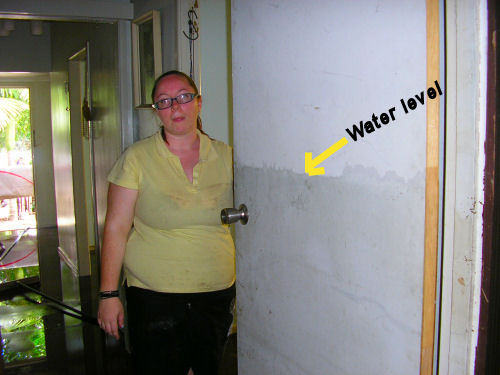
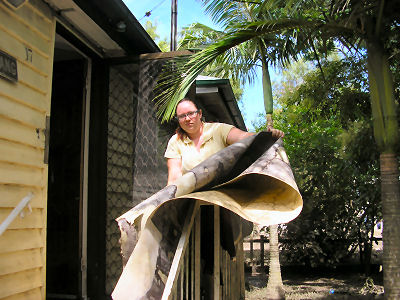
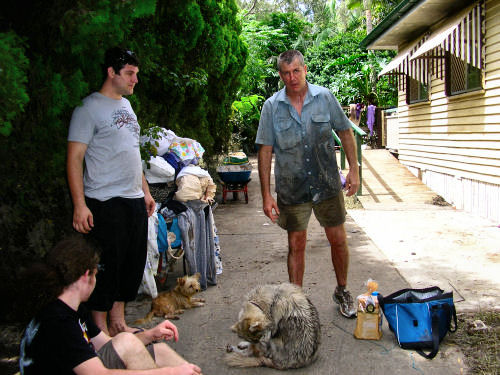

 Correspondence between two friends on the brink of major life changes driven by what looks to be climate change.
Correspondence between two friends on the brink of major life changes driven by what looks to be climate change.


 The Lockyer-Valley, Queensland, was the site of February 11-1-2011's devastating floods, including the ferocious flash floods on Murphys Creek. It shapes the pathway of the waters heading down to Brisbane and overfilling the Wivenhoe Dam, which is poised above that city. These photos from Google-Earth showing the topography (the form of the land) give many clues to the severity of the flooding. This article also asks questions about the Wivenhoe Dam and Government responsibility for its overfilling. In the Murphy's Creek flash flood, it seems you had weeks of rain causing totally sodden land, which could absorb no more rain, so when there were 60 solid minutes of rain, the denuded floodplains must have been like a smooth bath-tub. If you look at the area, the Lockyer Valley is a patchwork of treeless crop-sown riverflats with very little absorptive capacity. All around the valley are hills, feeding the river system. You can see Forest Hill bang smack in a river junction on the right and Toowoomba far left. Running down by the center of the valley is a huge long tarmacked highway.
The Lockyer-Valley, Queensland, was the site of February 11-1-2011's devastating floods, including the ferocious flash floods on Murphys Creek. It shapes the pathway of the waters heading down to Brisbane and overfilling the Wivenhoe Dam, which is poised above that city. These photos from Google-Earth showing the topography (the form of the land) give many clues to the severity of the flooding. This article also asks questions about the Wivenhoe Dam and Government responsibility for its overfilling. In the Murphy's Creek flash flood, it seems you had weeks of rain causing totally sodden land, which could absorb no more rain, so when there were 60 solid minutes of rain, the denuded floodplains must have been like a smooth bath-tub. If you look at the area, the Lockyer Valley is a patchwork of treeless crop-sown riverflats with very little absorptive capacity. All around the valley are hills, feeding the river system. You can see Forest Hill bang smack in a river junction on the right and Toowoomba far left. Running down by the center of the valley is a huge long tarmacked highway.
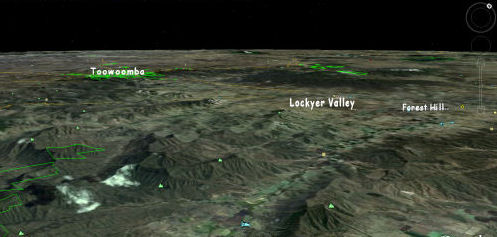
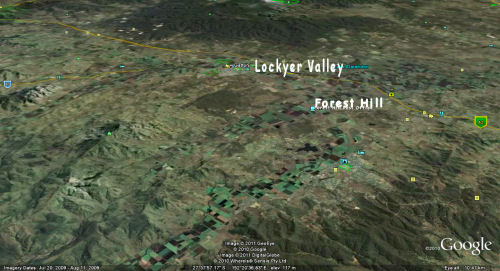


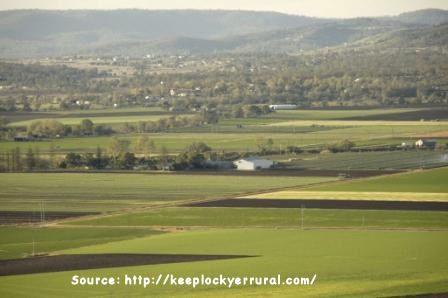
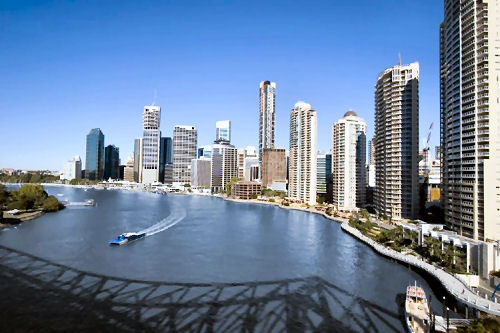
 As the first anniversary of Haiti's devastating earthquake approaches, the questions that I asked then (below) remain unasked and unanswered by the Canadian media today. Apparently, as Garrett Hardin famously observed, no one ever dies from over-population. And no one ever dies from Canada's criminally irresponsible foreign aid and immigration policies, which are serving as birth stimulants to those nations--- like Haiti---which are given little incentive to address the root cause of their misery.
As the first anniversary of Haiti's devastating earthquake approaches, the questions that I asked then (below) remain unasked and unanswered by the Canadian media today. Apparently, as Garrett Hardin famously observed, no one ever dies from over-population. And no one ever dies from Canada's criminally irresponsible foreign aid and immigration policies, which are serving as birth stimulants to those nations--- like Haiti---which are given little incentive to address the root cause of their misery.



 It has almost become commonplace now for prominent environmentalists like David Suzuki to declare that economic growth cannot continue in a finite world. Even Canadian Green Party leader Elizabeth May has been heard to quote Paul Ehrlich's old line that "growth is the ideology of the cancer cell". The problem is, however, that they do not follow this insight through to its logical conclusion. What does economic growth consist of? If population growth is a critical ingredient of economic growth, then what drives population growth? And if migration to affluent countries promotes population growth in both the nations of emigration and the recipient countries, must not any credible strategy to fight economic growth involve tightening borders and restricting this flow?
It has almost become commonplace now for prominent environmentalists like David Suzuki to declare that economic growth cannot continue in a finite world. Even Canadian Green Party leader Elizabeth May has been heard to quote Paul Ehrlich's old line that "growth is the ideology of the cancer cell". The problem is, however, that they do not follow this insight through to its logical conclusion. What does economic growth consist of? If population growth is a critical ingredient of economic growth, then what drives population growth? And if migration to affluent countries promotes population growth in both the nations of emigration and the recipient countries, must not any credible strategy to fight economic growth involve tightening borders and restricting this flow?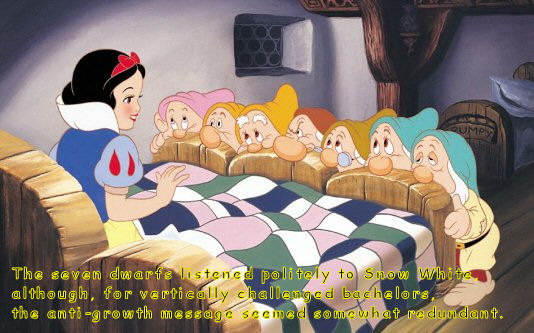 "We have come to believe that growth is the very definition of progress. You talk to any businessperson or politician and say, 'How well did you do last year?' And, within a picosecond, they will talk about growth in the GDP and the economy in profit, jobs or market share. And, anything in a finite world cannot grow forever. We live within the biosphere, that cannot grow- it's fixed." David Suzuki
"We have come to believe that growth is the very definition of progress. You talk to any businessperson or politician and say, 'How well did you do last year?' And, within a picosecond, they will talk about growth in the GDP and the economy in profit, jobs or market share. And, anything in a finite world cannot grow forever. We live within the biosphere, that cannot grow- it's fixed." David Suzuki
 Upon waking this morning, the first of January, I expect the media to lead off with what has become a tiresome ritual. Declaring the "winner" of the First-Baby-Of-The-Year Derby. Or should it be called "The Race To Extinction Derby"? Is there anything more symbolic of our collective stupidity and denial as celebrating the addition of the earliest born human being to a species that has rocketed to nearly 7 billion? I think it is timely then to reprise something I wrote a year and a half ago. I have not flinched in my fealty to these sentiments. It is something, which, if it appeared in the local community magazine, would ensure my lynching. That it would inspire such a reaction is proof, I think, of its veracity.
Upon waking this morning, the first of January, I expect the media to lead off with what has become a tiresome ritual. Declaring the "winner" of the First-Baby-Of-The-Year Derby. Or should it be called "The Race To Extinction Derby"? Is there anything more symbolic of our collective stupidity and denial as celebrating the addition of the earliest born human being to a species that has rocketed to nearly 7 billion? I think it is timely then to reprise something I wrote a year and a half ago. I have not flinched in my fealty to these sentiments. It is something, which, if it appeared in the local community magazine, would ensure my lynching. That it would inspire such a reaction is proof, I think, of its veracity.  The Australian land tax system creates hot treeless slums. In Queensland, for instance, the Brisbane City Council charges landowners according to the assessed market value of their land. If the Council land-zoning changes to allow medium or high density housing on land previously zoned only for detached homes, then the commercial value of that land goes up as each block will then be able to hold several dwellings instead of one. Although living conditions then become cramped and the quality of life for residents of higher density declines in comparison with that of residents of detached single dwellings, the total financial value of the medium density dwellings inevitably exceeds that of a single residence on the same land.
The Australian land tax system creates hot treeless slums. In Queensland, for instance, the Brisbane City Council charges landowners according to the assessed market value of their land. If the Council land-zoning changes to allow medium or high density housing on land previously zoned only for detached homes, then the commercial value of that land goes up as each block will then be able to hold several dwellings instead of one. Although living conditions then become cramped and the quality of life for residents of higher density declines in comparison with that of residents of detached single dwellings, the total financial value of the medium density dwellings inevitably exceeds that of a single residence on the same land.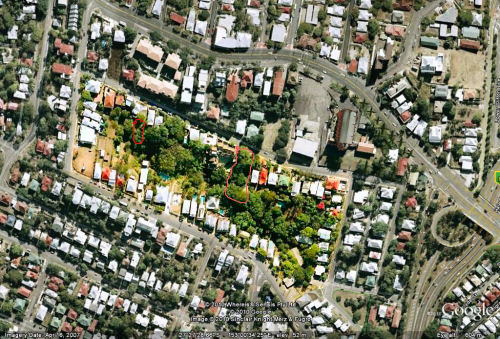


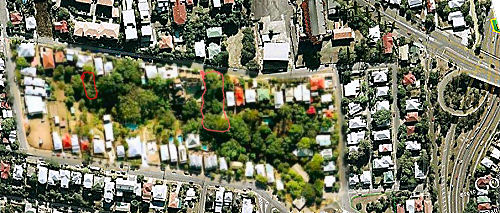
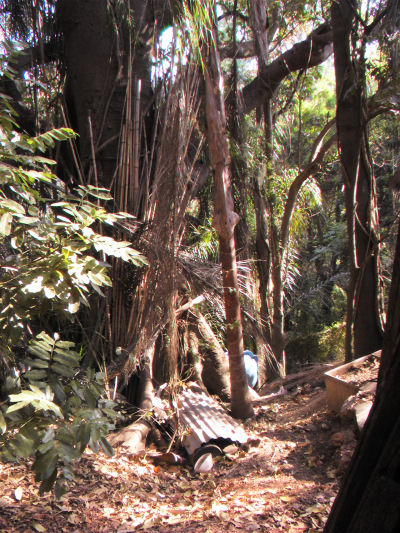 I know personally that the landowner with the three forested unbuilt blocks now sees little choice but to sell his land because the rates are so high. If he reluctantly goes ahead and the remnant rainforest is destroyed it will be more than a loss of natural beauty for Brisbane residents. Almost certainly the loss of the ecological services will make Brisbane a hotter and uglier. It will certainly not improve it. Those who can afford to will most likely draw on more electrical power to make their homes cool at least on the inside.
I know personally that the landowner with the three forested unbuilt blocks now sees little choice but to sell his land because the rates are so high. If he reluctantly goes ahead and the remnant rainforest is destroyed it will be more than a loss of natural beauty for Brisbane residents. Almost certainly the loss of the ecological services will make Brisbane a hotter and uglier. It will certainly not improve it. Those who can afford to will most likely draw on more electrical power to make their homes cool at least on the inside.













 Sweden has joined the United States, Britain, Spain and other nations as a target of politically motivated violence. It is no longer possible for countries such as the Netherlands and Sweden to think about their populations as homogenous groups with shared values and world views.
Sweden has joined the United States, Britain, Spain and other nations as a target of politically motivated violence. It is no longer possible for countries such as the Netherlands and Sweden to think about their populations as homogenous groups with shared values and world views. The media and various government websites clearly and openly qualifying native kangaroos and possums as 'pest animals' needing to be 'culled'. But what if they aren't pests at all? The law protects those who kill protected native species under certain conditions but could there be non-lethal ways of dealing with the problem? Could this be part of a national strategy to drive the nails deeper into our native animals' collective coffins? It is no wonder we have the world's worst record for mammal extinctions with government attitudes like this.
The media and various government websites clearly and openly qualifying native kangaroos and possums as 'pest animals' needing to be 'culled'. But what if they aren't pests at all? The law protects those who kill protected native species under certain conditions but could there be non-lethal ways of dealing with the problem? Could this be part of a national strategy to drive the nails deeper into our native animals' collective coffins? It is no wonder we have the world's worst record for mammal extinctions with government attitudes like this.


 The most effective way to conquer and colonize a people is to strip them of their identity as a people, as a distinctive culture and as a sovereign nation, and to delegate the wet work to a Puppet Intelligentsia. Like the Jews (Kapos) of the Warsaw ghetto whom the Nazis appointed to manage an orderly genocide, this contemptible class of rootless cosmopolitans, with media collusion, then set to work in convincing a new generation that they are part of a greater whole, a noble international enterprise, an empire, and that allegiance to the land of their forefathers is parochial, anachronistic, selfish and ‘nativist’. No sooner did we throw off the shackles of our infantile self-image as British ‘subjects’ when now, we are intoned to become “citizens of the world”. But we are not citizens in a global participatory democracy, but the passive consumers of global capitalism. In the name of diversity were are seeing what is left of our identity tossed into a global blender, with the left is calling it international workers solidarity. Face it. What we are witnessing is an invasion, and multiculturalism is just a useful smokescreen.
The most effective way to conquer and colonize a people is to strip them of their identity as a people, as a distinctive culture and as a sovereign nation, and to delegate the wet work to a Puppet Intelligentsia. Like the Jews (Kapos) of the Warsaw ghetto whom the Nazis appointed to manage an orderly genocide, this contemptible class of rootless cosmopolitans, with media collusion, then set to work in convincing a new generation that they are part of a greater whole, a noble international enterprise, an empire, and that allegiance to the land of their forefathers is parochial, anachronistic, selfish and ‘nativist’. No sooner did we throw off the shackles of our infantile self-image as British ‘subjects’ when now, we are intoned to become “citizens of the world”. But we are not citizens in a global participatory democracy, but the passive consumers of global capitalism. In the name of diversity were are seeing what is left of our identity tossed into a global blender, with the left is calling it international workers solidarity. Face it. What we are witnessing is an invasion, and multiculturalism is just a useful smokescreen.
 Planning issues dogged the Victorian ALP Government, although the ex-Planning Minister seemed remarkably unconcerned about community angst over high rise, high density development. Probably millions of dollars of the community's money and thousands of hours have been spent opposing unwanted, inappropriate developments especially in the established suburbs of Melbourne.
Planning issues dogged the Victorian ALP Government, although the ex-Planning Minister seemed remarkably unconcerned about community angst over high rise, high density development. Probably millions of dollars of the community's money and thousands of hours have been spent opposing unwanted, inappropriate developments especially in the established suburbs of Melbourne.  In terms of numbers, Green-Left ideologues are marginal. But they punch far above their weight. Their mission is plant preconceptions about eco-Malthusians in the minds of grass roots environmentalists and those few in the media would invite our input. Left unchallenged, this bad rap becomes conventional wisdom, and doors continue to slam in our faces. And these New McCarthyists know it. It is time we gave them a dose of their own medicine. We must expose their corporate funding sources and ask the obvious questions. Whose agenda are THEY serving? Whose interest is served by open borders? Are not the "eco-socialists" and "green" Trots Wall Street's useful idiots?
In terms of numbers, Green-Left ideologues are marginal. But they punch far above their weight. Their mission is plant preconceptions about eco-Malthusians in the minds of grass roots environmentalists and those few in the media would invite our input. Left unchallenged, this bad rap becomes conventional wisdom, and doors continue to slam in our faces. And these New McCarthyists know it. It is time we gave them a dose of their own medicine. We must expose their corporate funding sources and ask the obvious questions. Whose agenda are THEY serving? Whose interest is served by open borders? Are not the "eco-socialists" and "green" Trots Wall Street's useful idiots?

Recent comments